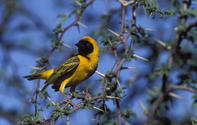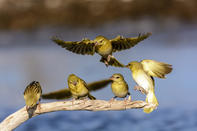Name
Southern masked-weaver (Ploceus velatus). Also known as a masked weaver.Appearance
The male southern masked weaver and the village weaver are very similar in appearance out of the breeding season, except that the village weaver is slightly larger.
During the breeding season, the southern masked-weaver is distinguished from the village weaver by not having a blotched back.
The southern masked-weaver has a yellow forehead and crown, with a black mask that extends only to the forehead.
The nape, back of the neck and breast are yellow. The eye is red and the bill is black. The male has very similar colouring as the female, outside of the breeding season.
The female has a throat that is a dull yellow colour, a dirty white belly and a mottled back that is olive in colour. The female’s eyes are brown and the bill is black.
Diet
The southern masked-weaver is omnivorous, mainly feeds on seeds, but will take arthropods and nectar when available.Southern Masked-weaver Breeding
The southern masked-weaver is polygynous (the breeding practice of a male breeding with more than one female at the same time) and colonial. The male will have up to 12 breeding females in his territory.
The southern masked weaver will build a nest and try and attract a female to the nest. When the female excepts the nest, she will line the nest with feathers, grass and leaves.
The female southern masked-weaver lays between 2 and 4 eggs, incubation is carried out by the female and the chicks hatch after 12 to 14 days.
The female feeds the chicks, which fledge after 16 to 20 days. The southern masked-weaver is parasitised by the Diederik cuckoo.
Behaviour
A male southern masked-weaver will build up to 25 nests in a season.
The nest is built out of reed, grass and palm leaves, in trees, bushes, reeds and man-made structures.
The southern masked weaver lays eggs in different colours.
This assists with evading being brood parasitised by the Diderick cuckoo.
The cuckoo does not know the colour of the eggs in the nest until it invades the weaver nest.
The female southern masked-weaver will reject any eggs that are a different colour to her own. The southern masked-weaver is very gregarious and will feed in flocks.

